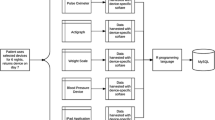Abstract
The amount and complexity of data accumulated in electronic health record (EHR) is quite large, and the quantity of information that clinicians can examine and handle is very limited. Thus, it is necessary to enhance the accessibility of EHR by improving the user experience (UX). To apply information visualization that turns EHR data into an understandable visual format, we propose following five screen design principles when designing UX interfaces. #1: One view should contain single patient data. #2: Data should be summarized or titled for overview and details should be given on-demand. #3: Data should be displayed in time-series. #4: Data should be categorized by primary type. #5: More data should be displayed at the same time. Three screen designs are plausible utilizing the above-mentioned principles. To measure the UX of screen designs and validate the design principles, we built an EHR viewer system that has three windows corresponding to these screen designs and had it tested by medical staff. The results of the test revealed that the UX of the screen design is proportional to the number of design principles that the screen design incorporates. It shows that the proposed screen design principles improve the UX of EHR.





Similar content being viewed by others
References
Häyrinen, K., Saranto, K., and Nykänen, P., Definition, structure, content, use and impacts of electronic health records: a review of the research literature. International journal of medical informatics 77(5):291–304, 2008.
Koppel, R., Metlay, J. P., Cohen, A., Abaluck, B., Localio, A. R., Kimmel, S. E., and Strom, B. L., Role of computerized physician order entry systems in facilitating medication errors. Jama 293(10):1197–1203, 2005.
Ware, C. (2012). Information visualization: perception for design. Elsevier.
Chen, M., Feixas, M., Viola, I., Bardera, A., Shen, H. W., & Sbert, M. (2016). Information theory tools for visualization. AK Peters/CRC Press.
Wang, T. D., Plaisant, C., Shneiderman, B., Spring, N., Roseman, D., Marchand, G., Mukherjee, V., and Smith, M., Temporal summaries: Supporting temporal categorical searching, aggregation and comparison. IEEE transactions on visualization and computer graphics 15(6):1049–1056, 2009.
Klimov, D., Shahar, Y., and Taieb-Maimon, M., Intelligent selection and retrieval of multiple time-oriented records. Journal of Intelligent Information Systems 35(2):261–300, 2010.
Plaisant, C., Milash, B., Rose, A., Widoff, S., Shneiderman, B., LifeLines: visualizing personal histories. Proc. of the SIGCHI conference on Human factors in computing systems 221–227, (1996).
Rind, A., Aigner, W., Miksch, S., Wiltner, S., Pohl, M., Turic, T., & Drexler, F. (2011). Visual exploration of time-oriented patient data for chronic diseases: Design study and evaluation. In Symposium of the Austrian HCI and Usability Engineering Group (pp. 301–320). Springer, Berlin, Heidelberg.
Evans, R. S. (2016). Electronic health records: then, now, and in the future. Yearbook of medical informatics, 25(S 01), S48-S61.
Medical Practitioners’ Act. Act No. 201 of 1948, Chapter 4, Article 24(1).
Rules for Professionals in Charge of Healthcare Services under Health Insurance Programs. Ordinance of the Ministry of Health and Welfare No. 15 of 1957, Article 22.
Ministry of Health, Labour and Welfare (2013) Security Guidelines for Health Information Systems Version 5. pp.96.
Thomas, T., and William, A., Measuring the User Experience: Collecting, Analyzing, and Presenting Usability Metrics. San Francisco: Morgan Kaufmann Publishers Inc., 2008.
Ordonez, P., desJardins, P., Lombardi, M., Lehmann, C., Fackler, J., An Animated Multivariate Visualization for Physiological and Clinical Data in the ICU. Proceedings of the 1st ACM International Health Informatics Symposium (IHI 2010) 771–779, (2010).
Anders, S., Albert, R., Miller, A., Weinger, M., Doig, A., Behrens, M., and Agtter, J., Evaluation of an integrated graphical display to promote acute change detection in ICU patients. International journal of medical informatics 81(12):842–851, 2012.
Faiola, A., Newlon, C., Advancing critical care in the ICU: a human-centered biomedical data visualization systems, in Ergonomics and Health Aspects. Proceedings of the International Conference on Human-Computer Interaction (HCII 2011) 119–128, (2011).
Acknowledgments
We are grateful to Mr. Tetsuo Tsuru, Ms. Tomoko Hikita, Dr. Akihiro Hamasaki, MD, Ph.D., Dr. Toyohiro Hirai, MD, Ph.D., Dr. Yumi Matsumura, MD, Ph.D. and Dr. Hideo Nakano, Ph.D. for their helpful discussions.
Author information
Authors and Affiliations
Corresponding author
Ethics declarations
Conflict of Interest
The authors declare that they have no conflict of interest.
Ethical Approval
All procedures performed in studies involving human participants were in accordance with the ethical standards of the institutional research committee and with the 1964 Helsinki declaration and its later amendments or comparable ethical standards. For this type of study, formal consent is not required.
Informed Consent
As mentioned in Ethical Approval, we concluded that formal consent is not required in the study. Therefore, informed consent was not obtained from participants included in the study.
Additional information
Publisher’s Note
Springer Nature remains neutral with regard to jurisdictional claims in published maps and institutional affiliations.
This article is part of the Topical Collection on Transactional Processing Systems
Rights and permissions
About this article
Cite this article
Fujita, K., Onishi, K., Takemura, T. et al. The Improvement of the Electronic Health Record User Experience by Screen Design Principles. J Med Syst 44, 21 (2020). https://doi.org/10.1007/s10916-019-1505-0
Received:
Accepted:
Published:
DOI: https://doi.org/10.1007/s10916-019-1505-0




